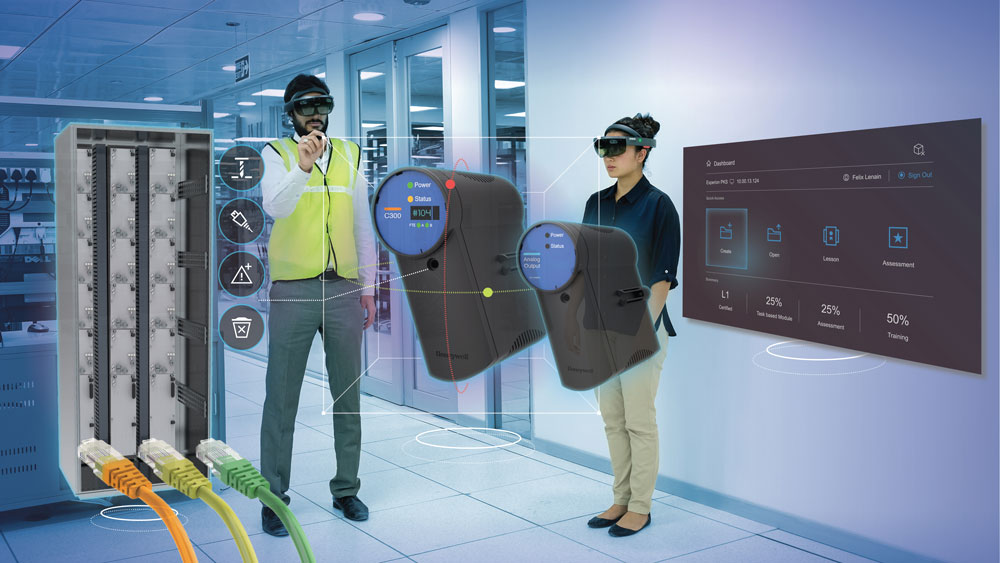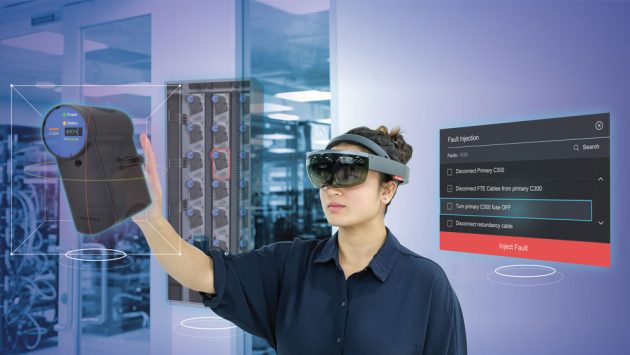
AR & VR: Sensory-rich training solutions
October 9, 2019
By Jennifer Paige
Virtual and augmented reality headsets are improving training times and skill retention, all while reducing costs, optimizing workflows and prioritizing safety
 Honeywell’s Immersive Competency uses augmented reality to provide practical, hands-on guidance, preparing industrial personnel for a variety of situations. Photo courtesy Honeywell
Honeywell’s Immersive Competency uses augmented reality to provide practical, hands-on guidance, preparing industrial personnel for a variety of situations. Photo courtesy Honeywell In an effort to improve safety and enhance the transfer of knowledge from experienced to new employees during the training process, North American manufacturing companies are beginning to employ augmented (AR) and virtual reality (VR) technologies.
“This technology is something that is really taking a hold,” says Craig Resnick, vice-president at ARC Advisory Group, a technology research and advisory firm for industry, infrastructure and cities.
“In the manufacturing industry it tends to be more of an evolution than a revolution, but I would say in three to five years you will probably see these systems being extremely commonplace as training tools. This technology is being very enthusiastically accepted on the factory floor and I think this is something that is going to have a significant impact on productivity and profitability.”
AR technology works by leveraging advanced sensors and computer vision to capture audio and visual cues that can document location and work processes. Using 2D and 3D eyewear, smartphones or tablets, AR can superimpose a computer-generated image on a user’s view of the real world, thus providing a composite view.
“Those who experience immersive, sensory-rich training simulations are more likely to recall what they learned.”
Mike McCready, an instructor and applied research chair in virtual and augmented reality at Lethbridge College in Alberta, is currently exploring and researching how VR/AR technologies can be used to improve training and day-to-day operations in various sectors.
“With AR, a lot of the value comes from on-the-job training and guidance. There are a number of AR devices that allow employees to pull up schematics or an operation manual of a device they are working on, load up real-time instrumentation data or share live video of the work environment with a supervisor – all voice activated. These devices [will] prove as invaluable assets to any technician, machine operator or tradesperson in the near future,” says McCready.
“Gone will be the days of flipping through a 100-page machine manual, stopping work to call a supervisor or struggling to operate or repair machinery.”
With the ability to superimpose digital information on real-world surroundings, navigating and instructing employees through new processes or facilities has become easier and safer, as the AR technology can highlight dangerous areas, pinpoint safe locations and provide real-time guidance.
“Say you are walking by a closed cabinet,” Resnick says. “This would be like having X-ray vision because the AR screen would be able to supplement what is inside the cabinet and provide different variables.” AR can also connect users with experts anywhere in the world as they work through various scenarios and tasks.
“Think of it as having an instructional YouTube video at your disposal,” Resnick says. “Let’s say you buy a new piece of furniture and you open the box and there are 8,000 different parts. Now imagine if you had a wearable that was instructing you on which part to take, how to connect everything, what tool you need and the next step. How much faster do you think you could assemble the piece of furniture? A third or half the time?”

Photo courtesy Honeywell
Sensory-rich simulations
VR takes training to a new level by providing the ability to fully immerse an employee in a simulated environment, allowing the user to roleplay, make decisions and live out the consequences.
“Traditional scenario-based training for emergencies can be challenging to accomplish while maintaining the safety of the employee,” says McCready. “With VR, unlimited scenarios could be created ranging from power failures, to fires, to chemical spills – all with zero risk to the employee and environment. These scenarios can be dynamic and responsive.
“It’s not just the various scenarios that can be programmed that make VR training an important option, it’s the effectiveness of the training as well. Those who experience immersive, sensory-rich training simulations are more likely to recall what they learned. This is because multiple senses are being stimulated, and [humans] think spatially.”
Lorne Fade, co-founder of VR Vision, a Toronto-based development studio that creates custom-tailored VR and AR training solutions for large companies in a number of sectors, explains that VR also allows the ability to easily replay recorded training sessions for unlimited replicability of complex training processes.
“This allows companies to train more people, faster, as well as increase learning retention overall. With optimized workflows and learning procedures, you are able to surpass audits and meet compliance regulations much more efficiently as well,” Fade says.
“This all leads to reduced costs, insurance premiums as well as environmental footprint. Not to mention the reduction of travel expenses […] companies in the past had to use specialized trainers by flying them around the world to facilities. With multi-player support in VR, we can now connect teams anywhere in the world for enhanced collaboration and easy access to specialists and expertise.”
In terms of safety training, VR allows employees to play out dangerous and rare scenarios, or virtually train in areas where the physical environment may be unavailable, such as remote or unsafe locations, or those that are under construction.
“The real benefits of using VR for training applications are that you are able to eliminate risky and harmful environments, which can prevent training injury and accidents,” Fade adds.
Resnick says that while employee safety throughout the training process is a top priority, the return on investment for manufacturing companies should not be understated. “One disaster averted as a result of having a confident and properly trained employee – the ROI is almost immediate.”
Applying AR/VR to the real world
In March 2018, Honeywell Process Solutions introduced an AR/VR cloud-based simulation tool to help enhance its training process. The company uses two headsets: Microsoft’s HoloLens, a self-contained holographic computer, and Windows Mixed Reality.
“Emerging technologies, such as AR or VR, can unlock new opportunities to secure, transfer and communicate knowledge,” says Veronica Turner, the Connected People business development lead, Americas at Honeywell Process Solutions. “Specifically, they allow for a true ‘learning-by-doing’ approach, letting operators practice critical industrial work activities in a safe, virtual space. Similar to a flight simulator, trainees can safely practice for daily activities and emergency situations, without putting at risk the live operation of a plant and its workers. This approach improves skill retention versus traditional training methods by up to 100 per cent and reduces the amount of training time for new operators by up to 60 per cent.”
With the immersive technology, Honeywell Process Solutions is able to simulate various scenarios for its C300 controllers, including certain tasks that do not occur often or that may present safety or production risks, such as primary failures, switchovers, or cable and power supply failure.
“We target specific job roles and develop custom programs aimed at developing concrete skills, where students are evaluated on their competency and not on the course itself,” says Turner. “This targeted approach shortens the learning curve, increases knowledge retention, boosts morale, and consequently increases employee satisfaction and retention.”
Getting started
In terms of implementing immersive technology as a training tool in the manufacturing sector, Fade says cost and timeline for implementation varies greatly depending on the specific needs of the AR/VR program and the kind of training content that is required. VR Vision, for example, works with clients to develop personalized VR/AR training applications. “The basic framework for this involves a lot of back and forth with clients to ensure the training process is accurate and meaningful.”
In terms of hardware, Fade suggests manufacturers should explore some of the latest available technology, including VR headsets such as the Oculus Quest, the Oculus Rift S or the HTC Vive Plus, and AR headsets such as the Microsoft HoloLens 2 or the RealWear HMT-1.
_____
Jennifer Paige is a freelance writer and editor at Annex Business Media.
This article originally appeared in the October 2019 issue of Manufacturing AUTOMATION.
Advertisement
- GM talks hit snag as union seeks products for UAW factories
- APEM launches e-stop switch with integrated connector